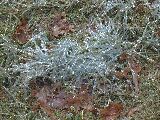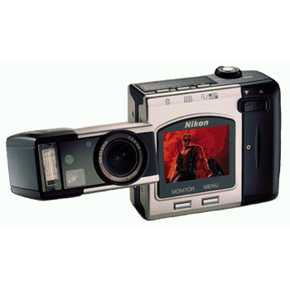











I am using the CoolPix 900, not the newer "s" version,
so my reviews and comments on the camera
should be taken only to apply to the former version.
This camera come with a high quality Nikkor zoom
lens which is roughly equivalent to 35 ~ 105 zoom on
a 35mm camera. The WC-E24 wide angle attachment
lens provides the equivalent of a 24mm wide angle lens
on a 35mm camera, and seems to me to produce
images of quality roughly equal to that of my 28mm f/2.8
Nikkor lens, though wider.
I love this camera! But I am going to dicuss some of the limitations of CCD photography.
The first thing that must be understood, especially by
an experienced film photographer, in using any
digital camera generally and the CoolPix 900 specifically
is that the CCD chip does not "see" the same
way film does. The art of photography is understanding
how film registers light, contrast and color
differently from the human eye. Once this knowledge
is acquired, it requires a big adjustment to go
from the world of emulsion photography to that of CCD
photography. Usually, dissatisfaction with
digital photography stems from the need to learn how
CCD "sees".
My experience is that the Coolpix 900's CCD has a much
more limited contrast range (lattitude) than film,
which in turn is of course much more limited than the
human eye. Scenes which contain what appears to
the eye to be blue sky (and would appear as such to film)
may be rendered as white space by the CCD if
the foreground is a couple of stops darker than the sky.
Film seems to have about three times the latitude
in my judgement, so this takes some getting used to.
Also, the camera sees color differently, loosing
some of the red component, especially when using auto white
balance in daylight or cloudy situations. This
can easily be addressed by the image editing software of choice.
Usually the addition of a little red perks up the images considerably.
On the other hand, pictures under indoor
lighting are rendered correctly instead of reddish /
orange. A trade off, requiring only some experience to turn
to an advantage.
The CCD / lens combination has tremendous depth of field,
requiring a great deal of thought about background. The background
will be rendered in extreme sharpness instead of falling off when your
subject is in the foreground. This is even true
when using the camera's tremendous macro / closeup capabilities.
This requires some thought and getting used to, and makes
it difficult to get that "wide stop" look, with a
sharp subject against an out of focus background.
For the experienced film photographer, what it all comes
down to is the need to go "back to school" and learn
the particular digital camera one is using. Each
brand / model seems to have some difference in the way it sees,
so some may be better suited to some users / purposes
than others.
I did have one major technical problem with respect to
using this camera - or more correctly, the "film" -
i.e. compact flash memory cards. I decided right
off the bat to get the minolta CD-10 SCSI PC card adapter
and a sub adapter that allows the use of compact flash
memory cards in the PC card slot. The SanDisk 8mb
memory card that came with the camera worked flawlessly
with the CD-10, but the first Viking brand 32mb
memory card I bought would not. Subsequently I
have found another Viking brand 32mb memory card that
works correctly with the CD-10. The difference
appears to be in a newer controller ship on the card. The
older cards apparently do not support all PC card services
correctly, and require you to use the painfully slow
serial cable interface to transfer pictures. How
slow is it? Don't even bother! Not only is it slow, it's a
resource
hog that will crash your system if you try to transfer
32mb of images in one session more times than not....
This having been said, I love this CoolPix 900!
Let me show you why..... (the pics that follow have been
substantially reduced in both size and information depth
- but not retouched! - in order to allow them to be used on this website,
so ultimately they only hint at the quality this camera
can achieve. The high quality 1280x960 pics it produces are
on average 550mb - the samples you will see here contain less than 1/6th
of the original information, having been reduced to 640x480...
select the samples you would like to view by clicking on
the thumbnail - but be patient - they'll take a while to
load...)
I will be adding more pictures of different types - people,
flash, action, wide angle, etc. - Check back for more, and let me hear
your comments!